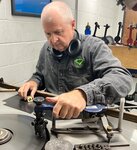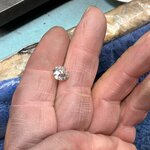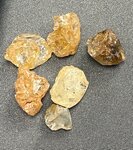



A treasure lies tucked away in the east side of Farmers Branch.
A non-descript building in the center of the commercial, light industrial and entertainment overlay zone, The Diamond Factory sign on the façade piques interest.
Inside, a fifth-generation diamond cutter from South Africa oversees a crew of specialists who cut both raw gems as well as refurbish damaged or heirloom diamonds for both wholesale and retail clients.
Ashley Van Creveld learned to cut diamonds during an apprenticeship after high school in the late 1980s.
His great- great-grandfather was a diamond cutter in Antwerp, Belgium, who moved the family to South Africa during World War 2.
His father moved the family back to Europe when Van Creveld was 17.
“At the time, it was very tumultuous in South Africa politically,” he said.
However, love intervened.
While his family moved to London, the family of the girl he was dating moved to Dallas.
Van Creveld followed. He married the girl and started Southwest Diamond Cutters, a wholesale diamond cutting factory, in 1993, because it was the only thing he knew, he said.
In the United States, the diamond cutting industry is focused in New York, but Van Creveld liked Dallas.
“Everyone said you can’t be a diamond cutter in Texas,” he said, but “I was really, really good at what I do, and I’m passionate about it.”
Van Creveld expanded from refurbishing diamonds to wholesale diamond cutting. Along the way, he trained and retrained others who wanted to learn the craft. His longest tenured employee arrived in the United States at the same time Van Creveld, and despite not knowing each other’s languages, became good friends and colleagues.
As the business grew with Van Creveld training new diamond cutters, co-workers became like family. Van Creveld said he created a work environment where he would want to work, and treats everyone with respect and like family.
“It’s hard work. It’s very detail-oriented, slow, time-consuming work,” he said. “There are easier ways to make a living. The reason they do it is because they have a passion for it, and as a result, they are exceptional at it.
The training process takes five years, with employees considered students for at least the first year. Everyone trains on actual diamonds.
“For the first five years, nothing is done without very, really close supervision,” he said.
As a result, the wholesale side of the business exploded from 2008 to 2012, creating clients from Alaska to the Florida Keys.
“We became very well-known nationwide for the refurbishing of diamonds,” he said
Van Creveld’s long-time friend, Barry Adler, who attended high school with Van Creveld in South Africa, became a certified diamond grader through the Gemological Institute of America (GIA) in 2005, and joined Van Creveld at Southwest Diamond Cutters. His interest was in retail, so they added a small retail shop, The Diamond Factory.
“The little showroom became a bigger showroom that became a bigger showroom,” Van Creveld said. “I never got to see the consumer enjoy the finished piece. It’s incredibly rewarding.”
“The concept is a little different [from other retailers] because you can see the diamonds being cut,” Adler said.
Nicole Ramirez, a graduate gemologist from the GIA, provides quality control for the company.
Her special training allows her to grade diamonds and ensure the diamonds cut at The Diamond Factory meet industry standards.
“It’s more complex than a lot of people think,” she said as she showed examples of hearts and arrows, which are different ways light refracts within a diamond. “I’ll check everything, but I’m not a diamond cutter. I’ve never cut a stone. I can’t tell these guys how to cut a stone.”
She demonstrated how the diamond cutters can use three-dimensional technology to scan rough stones to decide the best shape for a particular stone or how a particular cut would fit within a stone.
She said each cutter has different skill sets: fancy shapes, different shapes, antique cuts, cutting for color, and all of them collaborate with Van Creveld frequently.
“They’ve been working with each other for so long they have that give and take,” Nicole said. “Anything can throw off the parameters. It can be as small as a hair. When they say splitting hairs, this is what they mean.”
Van Creveld and Adler teamed up with David Blank of Diamond Doctor in 2020.
“David’s influence and retail experience allowed us to grow to a larger scale,” Adler said.
Both Van Creveld and Adler said the benefit of having diamonds manufactured, or cut, on site means customers can get the best deals on diamonds because the middleman is cut out.
“It’s a superior product from a technical standpoint,” Van Creveld said, and while diamonds are not inexpensive, he said the company tries to cater to every level or customer.
Adler said they like to create a special experience when customers come into the shop. “We treat them all like family and friends when they come in,” he said.
It’s a special treat for staff when people bring in old jewelry and want it made into new jewelry.
“We like to create and design custom pieces for people,” he said.
The focus of The Diamond Factory is diamonds: Engagement and wedding rings, tennis bracelets and necklaces, and diamond stud earrings, but the store also has a collection of pre-owned Rolex watches, which Adler said have become popular with both men and women.
The store also houses a small museum with replicas of the largest raw diamond ever found, the 3,105-carat Cullinan Diamond, which was discovered in South Africa in 1905, and several of the diamonds cut from it, including the diamonds that are set in King Charles III of England’s scepter and imperial state crown, the famed blue Hope Diamond and other famous diamonds.